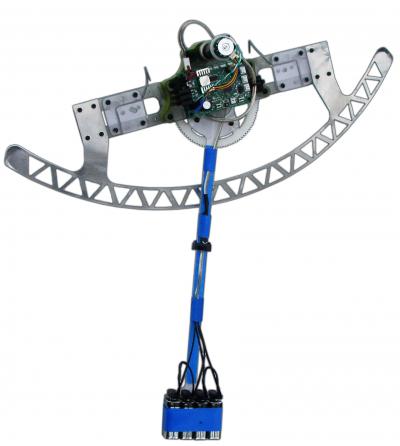Robot climbs walls
August 5, 2010

The ROCR Oscillating Climbing Robot developed by University of Utah mechanical engineer William Provancher and colleagues can climb carpeted walls efficiently using two hook-like claws, a motor and a tail that swings like a grandfather clock's pendulum. Weighing only 1.2 pounds and measuring 12.2 inches wide by 18 inches long, it has potential uses for surveillance, inspection, maintenance, teaching engineering and even as a toy. (William Provancher, University of Utah)
Wielding two claws, a motor and a tail that swings like a grandfather clock’s pendulum, a small robot named ROCR (“rocker”) built by University of Utah robot developers scrambles up a carpeted, 8-foot wall in just over 15 seconds — the first such robot designed to climb efficiently and move like human rock climbers or apes swinging through trees.
The motor that drives the robot’s tail and a curved, girder-like stabilizer bar attach to the robot’s upper body. The upper body also has two small, steel, hook-like claws to sink into a carpeted wall as the robot climbs. Without the stabilizer, ROCR’s claws tended to move away from the wall as it climbed and it fell.
The motor drives a gear at the top of the tail, causing the tail to swing back and forth, which propels the robot upward. A battery is at the end of the tail and provides the mass that is necessary to swing the robot upward.
“ROCR alternatively grips the wall with one hand at a time and swings its tail, causing a center of gravity shift that raises its free hand, which then grips the climbing surface,” the study says. “The hands swap gripping duties and ROCR swings its tail in the opposite direction.”
ROCR is self-contained and autonomous, with a microcomputer, sensors and power electronics to execute desired tail motions to make it climb.
University of Utah mechanical engineer William Provancher says that to achieve efficiency, ROCR mimics animals and machines. “It pursues this goal of efficiency with a design that mimics efficient systems both in nature and manmade,” he says. “It mimics a gibbon swinging through the trees and a grandfather clock’s pendulum, both of which are extremely efficient.”
More info: University of Utah news